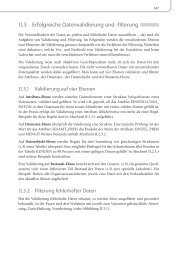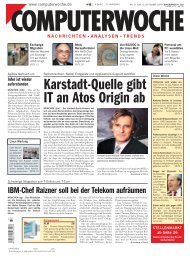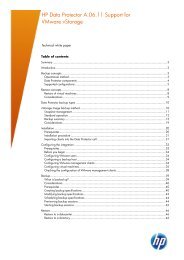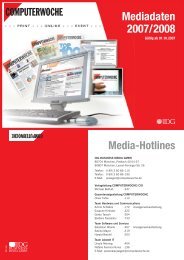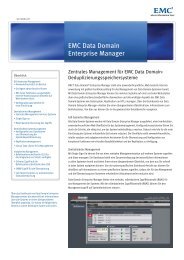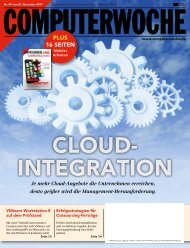The HP Business Intelligence Maturity Model: Describing the BI ...
The HP Business Intelligence Maturity Model: Describing the BI ...
The HP Business Intelligence Maturity Model: Describing the BI ...
Create successful ePaper yourself
Turn your PDF publications into a flip-book with our unique Google optimized e-Paper software.
to Stage 5 must also work on <strong>the</strong> speed with which<br />
<strong>the</strong>y are able to deliver new analytics to users as<br />
well as on understanding how emerging technologies<br />
affect <strong>the</strong> way users receive and process information.<br />
Finally, <strong>the</strong> move from Stage 4 to Stage 5 requires<br />
not just C-level sponsorship of <strong>the</strong> <strong>BI</strong> portfolio, but<br />
C-level commitment to embracing <strong>BI</strong> as a strategic<br />
lever for <strong>the</strong> business. Companies in Stage 4 should<br />
assess <strong>the</strong> readiness of <strong>the</strong>ir C-suite executives for this<br />
evolution and determine <strong>the</strong> change management and<br />
education initiatives required to make it happen.<br />
Stage 5: Creating strategic agility<br />
and differentiation<br />
Very few, if any, enterprises are truly at Stage 5 in<br />
all segments of <strong>the</strong>ir business model. This is <strong>the</strong> final<br />
stage where <strong>BI</strong> is built into <strong>the</strong> very fabric of every<br />
level of an organization, and predictive analytics are<br />
used across <strong>the</strong> board for most business decisions.<br />
Talk of service level agreements (SLAs), batch windows<br />
and user buy-in is long-past, and a fully-functional<br />
approach based on a service-oriented architecture<br />
allows for business model flexibility through true<br />
information agility. Systems, users, and tools are<br />
integrated, and are providing guidance, support, and<br />
leverage for <strong>the</strong> <strong>BI</strong> portfolio.<br />
<strong>Business</strong> enablement in Stage 5: In Stage 5, <strong>the</strong><br />
organization benefits from an agile information<br />
environment, in which information no longer prohibits<br />
strategic agility but promotes and enables it.<br />
Systemic, dynamic business modeling for competitive<br />
advantage becomes a reality. Analytics are seen as<br />
a key differentiator for <strong>the</strong> organization, not just as a<br />
value-adding activity. <strong>BI</strong> innovation becomes a core<br />
<strong>the</strong>me in <strong>the</strong> organization’s R&D investment portfolio.<br />
<strong>The</strong> benefits from highly integrated, syn<strong>the</strong>sized<br />
information and intelligence are widespread, and<br />
users at all levels of <strong>the</strong> organization have access to<br />
insights that help <strong>the</strong>m to work more effectively and<br />
optimize business outcomes.<br />
Information technology in Stage 5: In Stage 5,<br />
information management capabilities reach <strong>the</strong>ir<br />
highest level, wherein information is delivered via a<br />
service model. Integrated information is available<br />
seamlessly without regard to data source or integration<br />
technology used. Data governance and quality<br />
programs continue in full force, supported by C-level<br />
sponsorship and a pervasive belief in business<br />
ownership of <strong>the</strong> data and <strong>the</strong> importance of correcting<br />
data quality problems at <strong>the</strong>ir source. Unstructured<br />
and structured data are fully integrated. Advanced<br />
<strong>BI</strong> is fully embedded within processes, systems, and<br />
workflow. Information delivery efforts are characterized<br />
by agility, and new analytics are easily developed for<br />
new roles. Users are able to access <strong>the</strong> information<br />
<strong>the</strong>y need, when <strong>the</strong>y need it, delivered in a way that<br />
seamlessly supports <strong>the</strong>ir role in <strong>the</strong> organization.<br />
Strategy and program management in Stage 5:<br />
Stage 5 is characterized by <strong>the</strong> realization of <strong>the</strong><br />
full business value of <strong>BI</strong>. <strong>The</strong> C-level embraces <strong>BI</strong> as<br />
a lever for strategic change. A new role of Chief<br />
Analytics Officer might even emerge at this stage to<br />
guide <strong>the</strong> organization in using its information assets<br />
to outmaneuver <strong>the</strong> competition. Advanced <strong>BI</strong> portfolio<br />
management helps <strong>the</strong> organization achieve <strong>the</strong> full<br />
strategic value of its <strong>BI</strong> investments, and <strong>the</strong> company<br />
has a commitment to include <strong>BI</strong> on <strong>the</strong> agenda of its<br />
R&D organization.<br />
What’s next for companies in Stage 5: Once an<br />
organization reaches Stage 5 it must continue to<br />
evolve its <strong>BI</strong> capabilities by understanding and<br />
leveraging new technologies. This encompasses<br />
not only <strong>the</strong> next wave of innovation in information<br />
delivery from <strong>BI</strong> vendors, but also <strong>the</strong> new devices<br />
and technologies that have become a part of <strong>the</strong> way<br />
users work every day. Organizations in Stage 5 may<br />
also face challenges related to globalization. <strong>The</strong>ir<br />
<strong>BI</strong> portfolios must be able to adapt to geographical<br />
differences, whe<strong>the</strong>r in terms of data formats, sources,<br />
collection methods, privacy regulations or preferred<br />
methods for receiving and using intelligence. Reaching<br />
Stage 5 is an achievement in itself, but <strong>the</strong> exceptional<br />
organization that does so cannot afford to rest on its<br />
laurels. It must embrace an ongoing commitment to <strong>BI</strong><br />
innovation and to ensuring that <strong>the</strong> information needs<br />
of users at all levels of <strong>the</strong> organization are met.<br />
Conclusion<br />
<strong>The</strong> <strong>HP</strong> <strong>BI</strong> <strong>Maturity</strong> <strong>Model</strong> describes <strong>the</strong> path forward<br />
as companies work toward closer alignment of business<br />
and IT organizations. It is evident that <strong>the</strong> industry is<br />
maturing steadily, as Stage 3 topics like governance<br />
and master data management are common hot topics<br />
at leading conferences and in company boardrooms.<br />
<strong>The</strong> model also highlights a critical emerging need for<br />
a new breed of talent and leadership, namely program<br />
managers, business architects, and information<br />
architects, that can guide <strong>the</strong> next generation of<br />
integrated, high-value <strong>BI</strong> solutions.<br />
For more information<br />
For more information, visit www.hp.com/go/bi<br />
7




